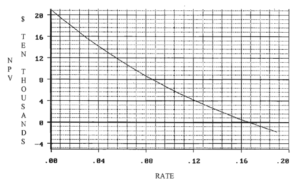6.5 Internal Rate of Return
When NPV is positive we know that the project being examined earns more than the required rate. When NPV is negative we know that the project being examined earns less than the required rate.
Only when NPV is zero does the project actually earn exactly the required rate. In this special case we can view the inflows as paying back our investment plus interest at the required rate. The internal rate of return (IRR) is the rate at which this happens, i.e., the rate for which:
[latex]\begin{align*} \text{PV Inflows}&= \text{PV Outflows}\\ NPV &= 0\\ \end{align*}[/latex]
Consider the manufacturing company in Example 6.3.1. In that case at a 20% effective rate of return the present value of inflows was
$208,333.33 and the present value of outflows was $233,333.33 so that:
[latex]NPV =$208,333.33 -$233,333.33= -$25,000.00[/latex]
We also found in Learning Activity #2 that the NPV at 15% was $13,641.07.
If the required rate is changed to 10% effective, the present value of inflows becomes $299,315.12 and the present value of outflows becomes $236,363.64 so that:
[latex]NPV=$299,315.12 - $236,363.64 = $62,951.48[/latex]
Similarly we can establish the following values:
| Required Rate | 16% | 17% |
| NPV | $5,156.73 | -$2,927.98 |
It should be clear that the rate which would make NPV = 0 is between 16% and 17% effective. From the graph below we can see that this value, the internal rate of return of this project, is about 16.6%.

The internal rate of return can be obtained from business calculators. In the case of the BAII Plus, place the cash flows in the calculator as for the NPV, remembering to clear all ([2ND][CF][2ND][CE|C]) before entering:
| CF0 = -200,000 | |
| C01 = -40,000 | F01 = 1 |
| C02 = 50,000 | F02 = 3 |
| C03 = 300,000 | F03 = 1 |
and then pressing [IRR][CPT]
You should see the answer, IRR= 16.63227%
Note that this is a solution to the equation:
[latex]\begin{align*} \text{PV Inflows} &= \text{PV Outflows}\\ \frac{$50,000}{(1+i)^2}+\frac{$50,000}{(1+i)^3}+\frac{$50,000}{(1+i)^4} +\frac{$300,000}{(1+i)^5} &= $200,000 +\frac{$400,000}{(1+i)^1} \end{align*}[/latex]
Which is quite difficult to solve by hand.
The answer in your calculator will always be a periodic rate for whatever period was used for the flows. Since the cash flows were yearly, the rate is an effective rate in this case. Since we are working with estimates, it is not uncommon to work exclusively with annual rates, as we do in this textbook.
Your Own Notes
- Are there any notes you want to take from this section? Is there anything you’d like to copy and paste below?
- These notes are for you only (they will not be stored anywhere)
- Make sure to download them at the end to use as a reference

